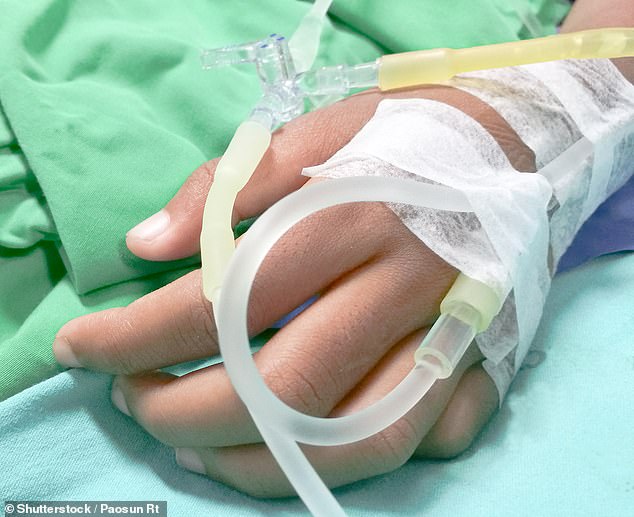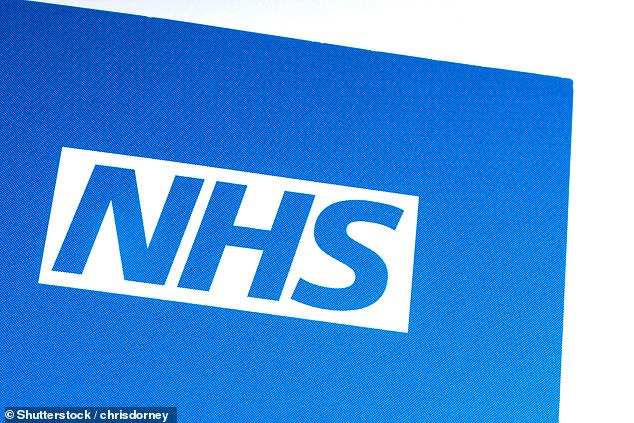Ensuring sick patients receive the full dose of the medication they have been prescribed may sound like a basic prerequisite of medical care.
Yet underdosing — as it is medically known — is a significant problem in the NHS that could be putting patients at risk, according to some experts.
It can occur when hospital patients are given drugs intravenously.
Once the bag of solution has emptied, it is removed along with the tube through which the liquid is infused into the patient, and both are thrown away.
But, inevitably, some liquid containing the medication will remain inside the tube, especially when the IV kit (or set, as it is also known) relies on gravity — without liquid in the bag, there is nothing to push the remainder in the tube into the patient.

Underdosing — as it is medically known — is a significant problem in the NHS that could be putting patients at risk, according to some experts. It can occur when hospital patients are given drugs intravenously
Under guidelines, doctors and nurses are meant to ‘flush’ the tube with saline so the patient doesn’t miss out on the residual dose. This should be done for all intravenous (IV) drugs, including antibiotics and painkillers (but is not necessary for hydration fluids).
To flush the line once an IV infusion has finished, a new small bag of saline (50-100ml) should be attached to the drip and the infusion started again, to push any residual medication into the patient.
The National Infusion and Vascular Access Society (NIVAS), which represents healthcare workers involved in the administration of IV drugs and vascular access, issued the new guidance in February 2021 after two studies last year suggested up to a third of the dose of medication could be lost if the line is not flushed.
While line-flushing is standard practice in cancer care and paediatrics, on other wards ‘it is rarely done’, according to Rachel Dixon, an enteral nurse specialist and a former NHS infusion manager, who has brought the largely unrecognised issue of underdosing to the attention of NHS England.
‘The view seems to be that when the IV bag has emptied, the full dose has been given. But that isn’t the case,’ she says. ‘A proportion of it will still be in the tube and, if this is not flushed, the patient won’t get the full dose.
‘We should be giving drugs as prescribed, not as we fancy; we should be throwing away saline, not medication. This bad practice is a country-wide problem.’
A 2018 study across six departments in a large UK teaching hospital found that overall, 74 per cent of IV sets were not flushed over the course of a week. This rose to 99 per cent on surgical wards, 80 per cent on critical care and high-dependency units, and 89 per cent on the emergency admission unit.
None of the IV sets containing painkillers and antibiotics was flushed — and ‘almost one third’ had antibiotics still in them, with up to 21 per cent of the dose being thrown out, said the researchers.

While line-flushing is standard practice in cancer care and paediatrics, on other wards ‘it is rarely done’, according to Rachel Dixon, an enteral nurse specialist and a former NHS infusion manager, who has brought the largely unrecognised issue of underdosing to the attention of NHS England
Oncology was the only department where all IV sets were flushed, according to the study in the British Journal of Nursing.
Another UK study, published in the journal JAC — Antimicrobial Resistance in August last year, estimated up to 33 per cent of antibiotics may be lost; while a U.S. study, published in the Journal of Infusion Nursing also last year, found it was 35 per cent.
The potential impact of underdosing is far-reaching. ‘If patients don’t receive the prescribed dose of medication, it may impact on their recovery times, which means a longer, more costly stay in hospital,’ says Rachel Dixon, pointing to reports of underdosing being a cause of treatment failure in patients with malaria.
In its guidance, NIVAS admits that ‘flushing IV infusion sets in adult patients is rare’. Between 20ml and 30ml of drug solution may be lost, it says, which could be ‘half the dose of a 50ml bag’, adds Rachel.
Under the new guidelines, medical staff are advised to flush the lines and use a new IV set for each different drug.
In 2017, NHS England issued a Patient Safety Alert warning that a patient’s IV line should be flushed or removed at the end of each surgical procedure to prevent any residual anaesthetic or sedative drugs being inadvertently given to the same patient later, causing ‘muscle paralysis, unconsciousness and respiratory and cardiac failure’.
Between 2014 and 2017, 58 such incidents were reported.
In one case, a young woman, known only as Kathryn, was temporarily paralysed and went into respiratory arrest after residual anaesthetic drugs — given to her during an operation to remove her appendix in 2015 — were not flushed from the cannula before antibiotics were put through the same tube a few hours later.
‘When the nurse administered antibiotics, this flushed the paralysing agent into me,’ she said later. ‘I felt this rush go through my body and everything started to seize up. It really panicked me and I could feel the air coming out of my lungs. I was conscious but completely paralysed — I couldn’t open my eyes or communicate.
‘Within an hour the anaesthetist who had made the error came and sat by my bedside,’ she said. ‘He was devastated. It was a very costly mistake for both of us.’
Kathryn was later diagnosed with post-traumatic stress disorder.
According to Andrew Barton, chair of NIVAS and editor of the guidelines, improvements in the design of IV kit mean the residual volume is likely to be much less than the recent studies suggest — even less than 5 per cent, he says.
Reflecting on the problem, he told Good Health: ‘Unfortunately, for some reason it had become common practice over the past 20 years to discard IV sets from the general adult population without flushing the line which may contain residual medication. No one was aware this was happening.
‘We know line-flushing does occur in high-risk areas such as cancer, critical care and paediatrics, for example. It is now down to hospitals to assess other wards and change practice accordingly.’
Flushing IV sets has time and cost implications (because hospitals would need additional bags of saline), and may carry a risk of overloading the patient with fluid (though this can be prevented by using the right amount of saline).
In addition, disconnecting and restarting an IV device to administer the ‘washout’ saline can increase the risk of infection.
Some believe this may be less of an issue with antibiotics. For the 245,000 people diagnosed with sepsis each year in the UK, IV antibiotics are key to recovery.
Dr Ron Daniels, head of the UK Sepsis Trust, says: ‘Some patients may miss out on 5 to 10 per cent of their dose of drugs if no line-flushing takes place, which is technically illegal as it is a prescribed medication,’ he says.
‘We support the use of safe, effective line-flushing. However, antibiotic doses are very general, so losing 5 or 10 per cent probably won’t transform patient care.’
Andrew Barton agrees: ‘When a patient is on IV antibiotics we take blood to check how they are responding to antibiotics and adjust the dose accordingly.
‘We need to do more research into this issue, but I am confident this is not a massive scandal.’
But Rachel Dixon insists action is needed to stamp out the practice: ‘Oncology and paediatrics get it, but it seems to be a blind spot for other departments.
‘We need the same consistent approach across all of the NHS so that patients receive the dose of medication they were prescribed. Otherwise some people will change their ways, but others won’t.’
Old pill helps tackle women’s acne
By Matthew Watts for the Daily Mail
A 60-year-old blood pressure drug could be used as a radical new treatment for acne in women.
A major new UK trial is under way to assess whether spironolactone, launched as a treatment for high blood pressure in 1960, helps the skin condition, too.
While the drug treats high blood pressure by removing excess water from the bloodstream, easing pressure on artery walls, one of its side-effects is reducing the ability of testosterone to bind to receptors on skin cells.
Excess production of testosterone increases the activity of oil glands, causing clogged pores and spots.
For several years, dermatologists in the UK have been using spironolactone, which is also licensed for use in heart failure and kidney disease, to treat severe acne in women on an ‘off label’ basis. This is where drugs licensed for one purpose are used for something different when there is good evidence that they help.
Several small studies have highlighted the benefits of spironolactone for acne in women. Now 400 women with acne in the UK are being recruited to take part in one of the biggest investigations so far, at nine hospitals across the UK. (Spironolactone for acne is not being tested on men, as reducing their testosterone levels can affect sex drive, thin body hair and weaken muscles.)
Acne affects 90 per cent of people in the UK at some point in their lives, mostly during adolescence. But up to 30 per cent of adult women are also affected, often during pregnancy and menopause. Treatment creams can be effective but some people find them difficult to use. Another common treatment is antibiotics, known as tetracyclines. These can give good results but can also have serious side-effects — such as making the skin more sensitive to the sun and reducing the effectiveness of the oral contraceptive pill.
Another option is retinoids, which come as pills or creams and work by removing dead skin cells that clog pores. But side-effects include skin sensitivity, dry eyes and throat, headaches and general aches. In rare cases they have been linked with depression.
Dr Miriam Santer, a professor of primary care research at the University of Southampton, who is leading the new study, said: ‘We think spironolactone could replace oral antibiotics for acne in some women and offer an alternative where other treatments haven’t worked or aren’t suitable.’
Source link : https://www.dailymail.co.uk/health/article-9986907/The-dangers-not-getting-drop-drip.html











